闵炬1,
史培华2,
马明坤1,
郝雅琼1,
施卫明1,,
1.中国科学院南京土壤研究所/土壤与农业可持续发展国家重点实验室 南京 210008
2.江苏农林职业技术学院农学园艺学院 句容 212400
基金项目:国家重点研发计划项目(2016YFD0801102)、山东省重大科技创新工程项目(2019JZZY010701)和江苏省自然科学基金(BK20170586)资助
详细信息
作者简介:王远, 主要研究方向为农田面源污染防控和作物氮素营养诊断。E-mail: wangyuan@issas.ac.cn
通讯作者:施卫明, 主要研究方向为农田面源污染防控和植物营养分子生物学。E-mail: wmshi@issas.ac.cn
中图分类号:X511; S-3计量
文章访问数:89
HTML全文浏览量:20
PDF下载量:31
被引次数:0
出版历程
收稿日期:2021-04-07
录用日期:2021-06-08
网络出版日期:2021-07-14
刊出日期:2021-12-09
Comparison of two monitoring methods for ammonia volatilization based on rice-wheat rotation system
WANG Yuan1,,MIN Ju1,
SHI Peihua2,
MA Mingkun1,
HAO Yaqiong1,
SHI Weiming1,,
1. Institute of Soil Science, Chinese Academy of Sciences / State Key Laboratory of Soil and Sustainable Agriculture, Nanjing 210008, China
2. Department of Agronomy and Horticulture, Jiangsu Vocational College of Agriculture and Forestry, Jurong 212400, China
Funds:This study was supported by the National Key Research and Development Program of China (2016YFD0801102), the Key Research and Development Program of Shandong Province of China (2019JZZY010701) and the Natural Science Foundation of Jiangsu Province of China (BK20170586)
More Information
Corresponding author:E-mail: wmshi@issas.ac.cn
摘要
HTML全文
图
参考文献
相关文章
施引文献
资源附件
访问统计
摘要
摘要:氨挥发是农田活性氮损失的重要途径, 准确、有效地测定农田氨排放量是环境评估和政策制定的基础。由于氨挥发监测方法多样, 且方法间缺少系统的对比分析, 在一定程度上限制了相关研究数据的进一步利用。我国应用最广泛的氨挥发监测方法是通气式海绵吸收法和密闭室间歇抽气法, 目前, 两种监测方法仍缺少大田条件下的实测对比。本研究在不同施氮量处理下, 于水稻-小麦轮作系统作物生长期同时采用这两种方法对土壤氨挥发排放进行连续监测。结果表明, 在3个施氮水平下, 通气式海绵吸收法测得的氨挥发累积量低于密闭室间歇抽气法25%~35%, 稻麦两季结果一致, 两方法测试值的变化趋势也一致。通气式海绵吸收法在稻季测得累积氨挥发量为17.36~43.90 kg?hm?2, 麦季为5.90~20.43 kg?hm?2, 排放系数为2.56%~10.39%; 密闭室间歇抽气法在稻季测得累积氨挥发量为23.28~61.05 kg?hm?2, 麦季为14.63~27.73 kg?hm?2, 排放系数为7.09%~15.01%。相同研究区域的文献调研表明, 当施氮量为101~300 k?hm?2时, 通气式海绵吸收法比密闭室间歇抽气法低5%~25%, 与实测数据趋势相同。基于本研究和文献调研结果, 推荐通过这两种监测方法获取的氨挥发量在施氮量低于100 kg?hm?2时可不转换, 施氮量高于100 kg?hm?2时可按照密闭室间歇抽气法的75%转换为通气式海绵吸收法。
关键词:氨挥发/
氮肥用量/
密闭室间歇抽气法/
通气式海绵吸收法/
稻麦轮作
Abstract:Ammonia volatilization is an important pathway of active nitrogen (N) loss from farmlands. The accurate and effective measurement of farmland ammonia emissions is the basis for environmental assessments and policymaking. Soil ammonia volatilization is controlled by fertilizer application rates, fertilizer application methods, soil properties, and meteorological conditions, so there is a wide variability in the cumulative ammonia emissions and emission factors in different studies. There are also different methods for ammonia volatilization measurements, which further reduce the comparability of data across studies. The most widely used methods for soil ammonia volatilization measurements in China are the ventilated sponge absorption method and the intermittent airflow enclosure method. However, consistency between measurements is unclear because of substantial differences in the ventilation rates between methods, and only a few studies have compared the two methods. Based on a typical rice-wheat rotation system in the Lower Reaches of the Yangtze River, this study set up treatments with different N fertilizer application rates (N0: no N fertilizer; N1: 200 kg(N)·hm?2 for rice and 180 kg(N)·hm?2 for wheat; N2: 300 kg(N)·hm?2 for rice and 270 kg(N)·hm?2 for wheat; and N3: 400 kg(N)·hm?2 for rice and 360 kg(N)·hm?2 for wheat). Soil ammonia volatilization was measured continuously after fertilization during rice and wheat growth using the ventilated sponge absorption and intermittent airflow enclosure methods, and the ammonia emission factors in the study area were analyzed using literature analysis. The results showed that the cumulative ammonia emission measured by the ventilated sponge absorption method was 25%–35% lower than that measured by the intermittent airflow enclosure method under the three N application treatments (except for the N0 treatment), and the results were consistent for both rice and wheat seasons. Under fertilization treatments (N1, N2 and N3), the cumulative ammonia emissions measured by the ventilated sponge absorption method ranged from 17.36 to 43.90 kg·hm?2 in the rice season and from 5.90 to 20.43 kg·hm?2 in the wheat season, with emission factors ranging from 2.56% to 10.39%. The cumulative ammonia emissions measured by the intermittent airflow enclosure method ranged from 23.28 to 61.05 kg·hm?2 in the rice season and from 14.63 to 27.73 kg·hm?2 in the wheat season, with emission factors ranging from 7.09% to 15.01%. The cumulative ammonia emissions under the N0 treatment were higher for the ventilated sponge absorption method than for the intermittent airflow enclosure method, and the measurements of the two methods were significantly different in the rice season but not in the wheat season. The results of the literatures analysis in the study area were consistent with the monitoring results. The cumulative ammonia emissions measured by the ventilated sponge absorption method were higher than those measured by the intermittent airflow enclosure method when the N application rate was between 0 and 100 kg·hm?2, with average emission factors of 6.18% and 12.31%, respectively. When the N application rate was between 101 and 200 kg·hm?2, the ventilation sponge absorption method led to 25% lower emissions than the intermittent airflow enclosure method, with average emission factors of 9.46% and 12.61%, respectively. When the N application rate was between 201 and 300 kg·hm?2, the ventilation sponge absorption method led to 5% lower emissions than the intermittent airflow enclosure method, and the average emission factors were 12.71% and 13.43%, respectively. In general, the cumulative ammonia emissions measured by the two methods were consistent; the ventilated sponge absorption method led to higher measured values than the intermittent airflow enclosure method in fields without N application or with low ammonia volatilization rates, and the ventilated sponge absorption method led to lower measurements than the intermittent airflow enclosure method in fields with N application. The measurements of the two methods can be converted using a ratio. The results of this study provide support for the estimation of regional ammonia emissions using the ventilated sponge absorption and intermittent airflow enclosure methods.
Key words:Ammonia volatilization/
Nitrogen fertilizer amount/
Intermittent airflow enclosure method/
Ventilated sponge absorption method/
Rice-wheat rotation
HTML全文

图1试验期间试验点的日均温和降雨量
黑色箭头表示施肥事件。The black arrows indicate fertilization events.
Figure1.Average daily temperature and rainfall at the experimental site during the experiment period
 下载: 全尺寸图片幻灯片
下载: 全尺寸图片幻灯片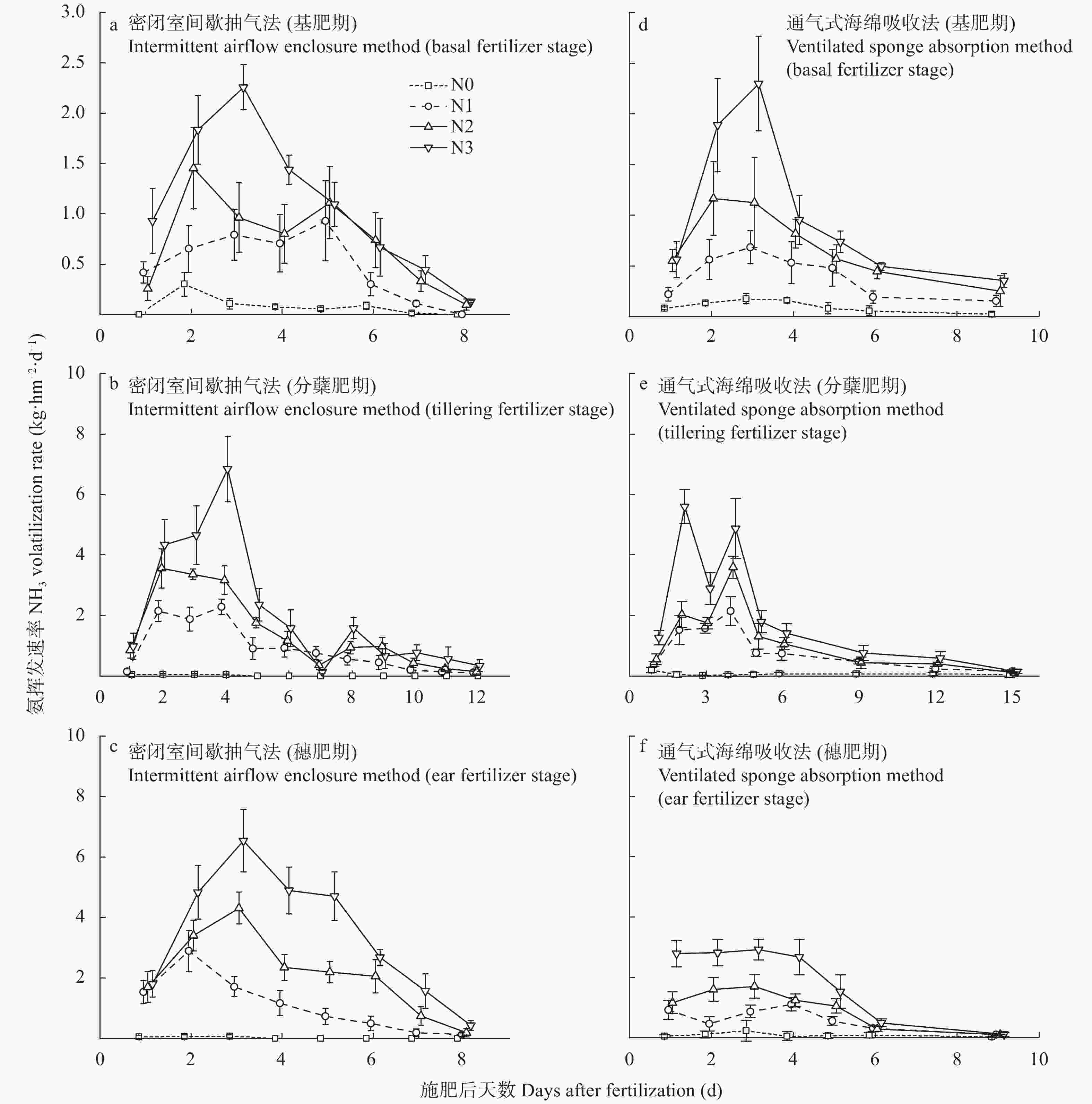
图2水稻季不同施肥期两种氨挥发监测方法测定的土壤氨挥发速率
Figure2.Soil ammonia volatilization rates relative to fertilization period in the rice season measured by two ammonia volatilization monitoring methods
 下载: 全尺寸图片幻灯片
下载: 全尺寸图片幻灯片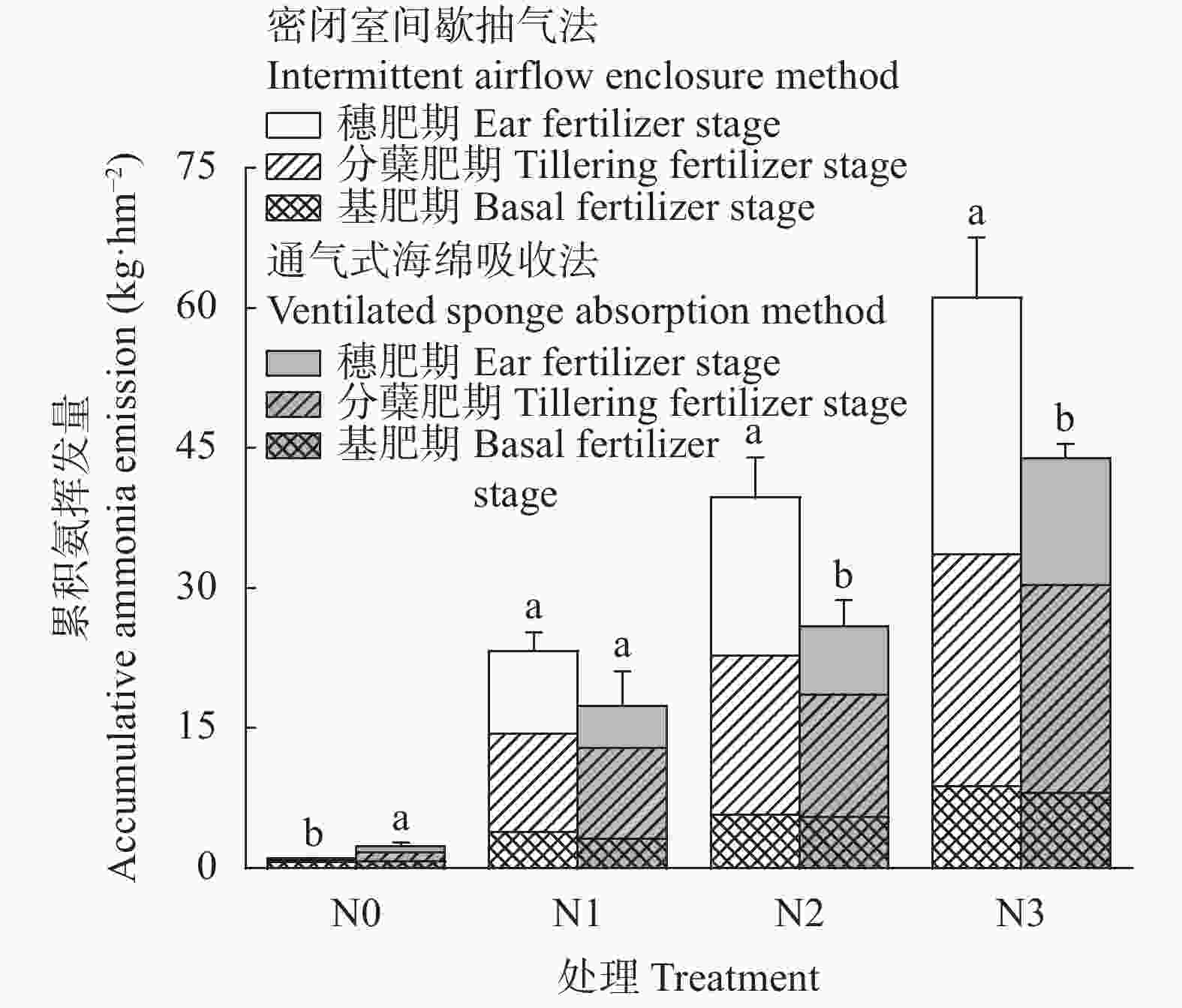
图3两种氨挥发监测方法测定的水稻季土壤累积氨挥发量
不同小写字母表示同一处理下两种氨挥发监测方法间差异显著(P<0.05)。Different letters mean significant difference between two ammonia volatilization monitoring methods under the same treatment (P<0.05).
Figure3.Accumulative ammonia emission in the rice season measured by two ammonia volatilization monitoring methods
 下载: 全尺寸图片幻灯片
下载: 全尺寸图片幻灯片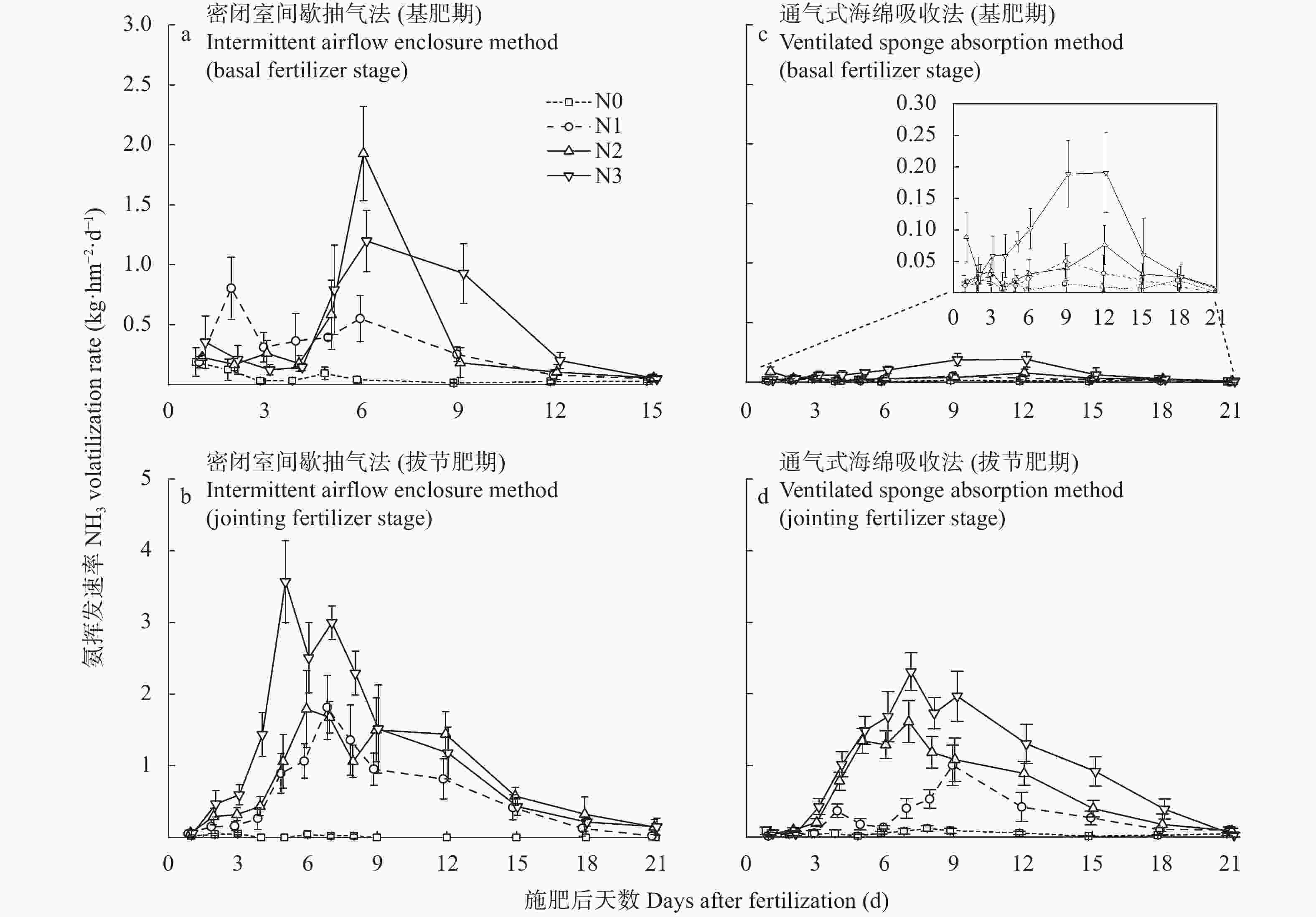
图4小麦季不同施肥期两种氨挥发监测方法测定的土壤氨挥发速率
Figure4.Soil ammonia volatilization rates relative to fertilization period in the wheat season measured by two ammonia volatilization monitoring methods
 下载: 全尺寸图片幻灯片
下载: 全尺寸图片幻灯片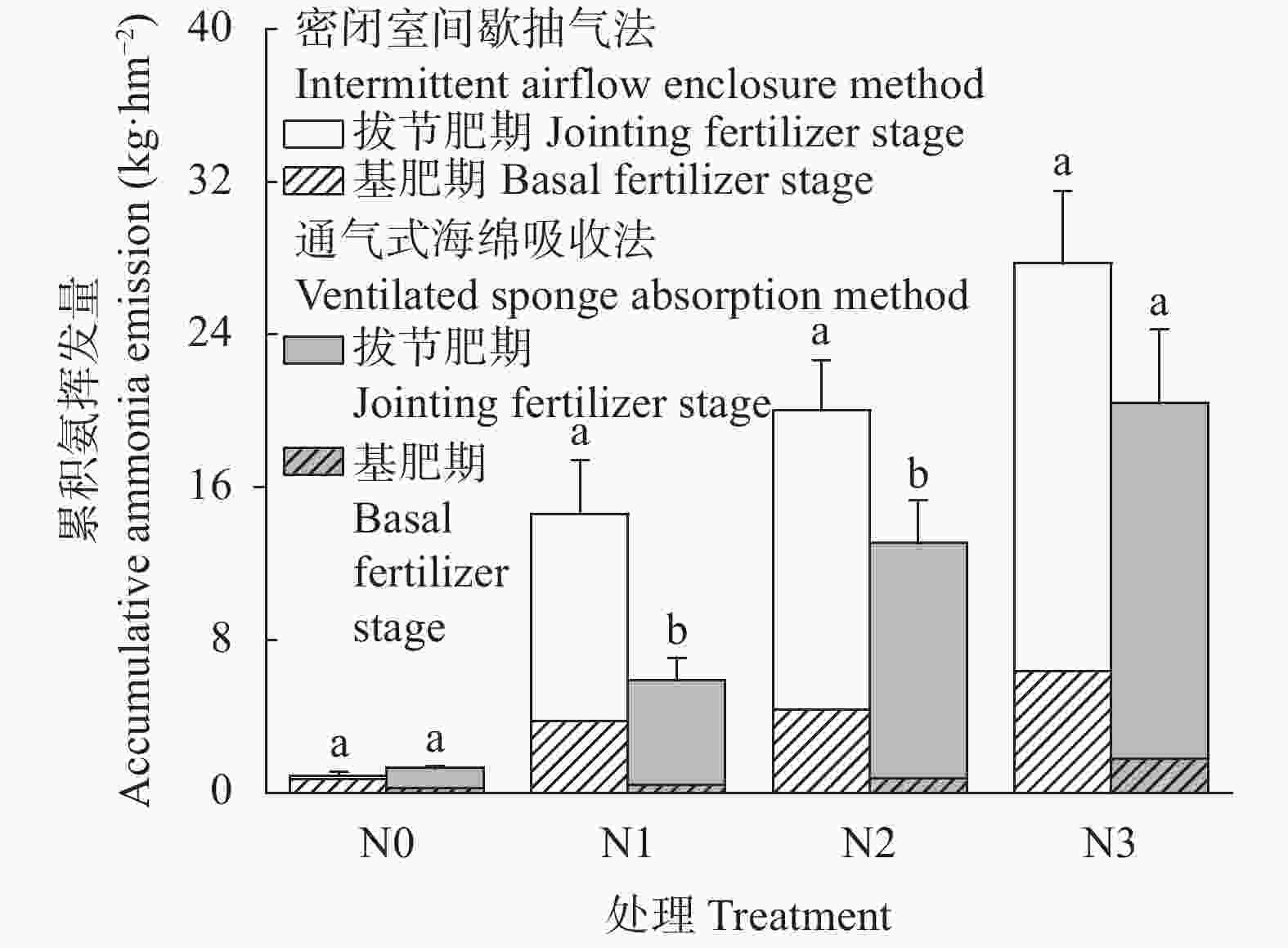
图5两种氨挥发监测方法测定的小麦季土壤累积氨挥发量
不同小写字母表示同一处理下两种氨挥发监测方法间差异显著(P<0.05)。Different letters mean significant difference between two ammonia volatilization monitoring methods under the same treatment (P<0.05).
Figure5.Accumulative ammonia emission in the wheat season measured by two ammonia volatilization monitoring methods
 下载: 全尺寸图片幻灯片
下载: 全尺寸图片幻灯片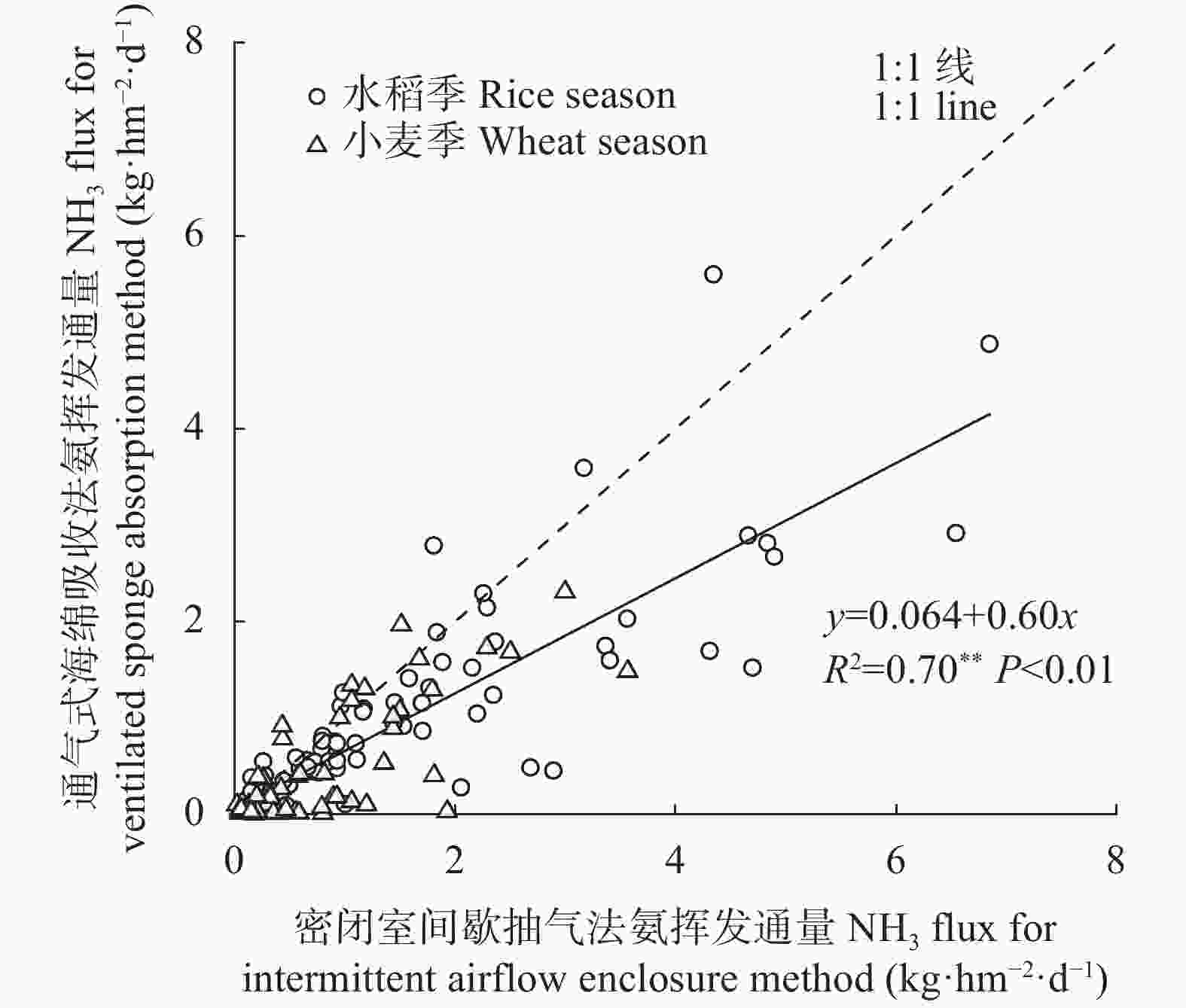
图6两种氨挥发监测方法测定的氨挥发通量比较
Figure6.Comparison of NH3 fluxes between the two ammonia volatilization monitoring methods
 下载: 全尺寸图片幻灯片
下载: 全尺寸图片幻灯片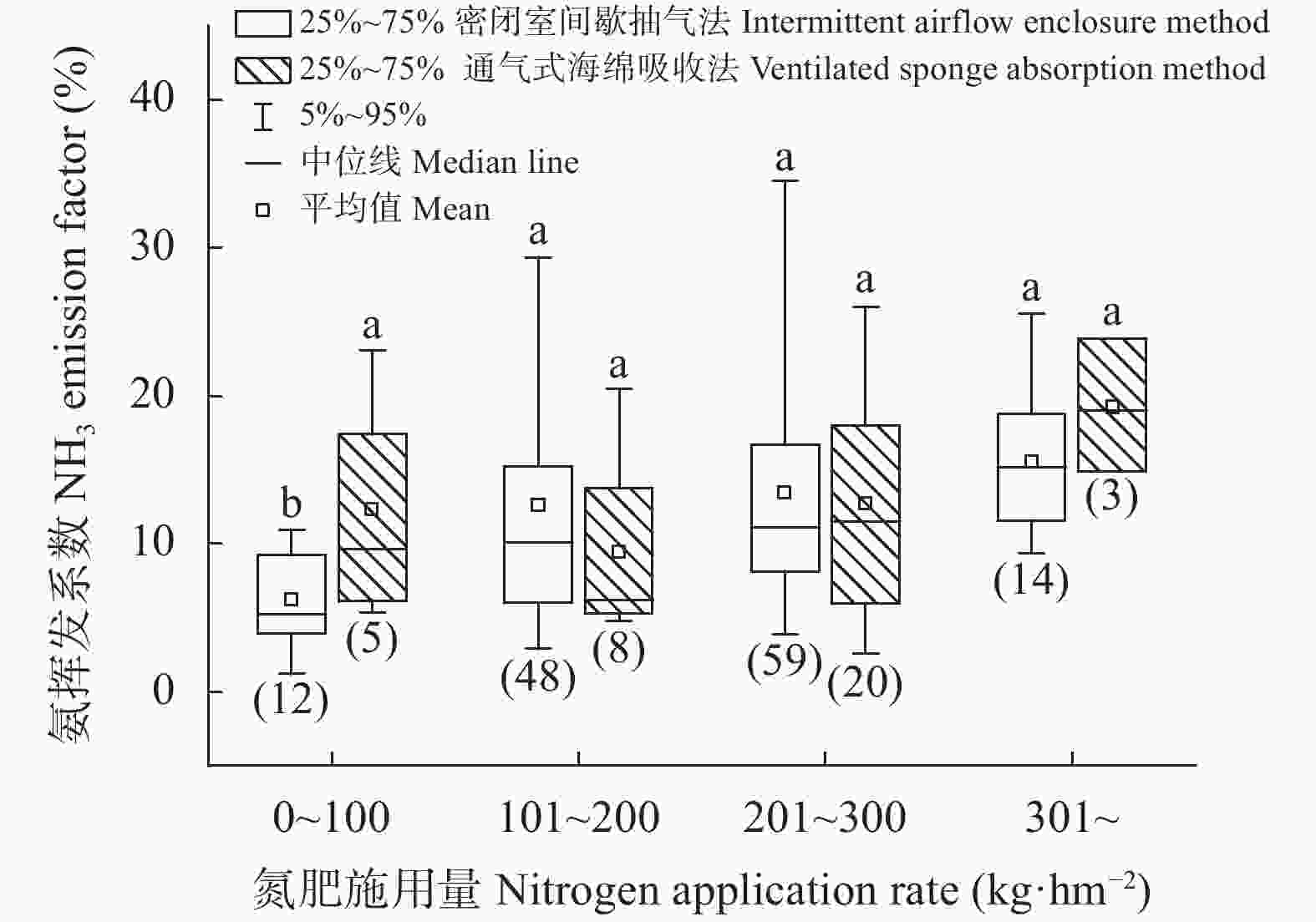
图7两种氨挥发监测方法测定的排放系数文献调研分析
括号内数字为相应的样本量。The numbers in brackets are the corresponding sample sizes.
Figure7.Literature analysis on NH3 emission factor of the two ammonia volatilization monitoring methods
 下载: 全尺寸图片幻灯片
下载: 全尺寸图片幻灯片表1两种氨挥发监测方法的回收率
Table1.Recovery rates of the two ammonia volatilization monitoring methods
| 样品号 Sample No. | 密闭室间歇抽气法 Intermittent airflow enclosure method | 通气式海绵吸收法 Ventilated sponge absorption method | |||||
| 溶液挥发氨量 NH3 volatilized from the source solution (mg, N) | 装置吸收氨量 NH3 trapped by the equipment (mg, N) | 回收率 Recovery rate (%) | 溶液挥发氨量 NH3 volatilized from the source solution (mg, N) | 装置吸收氨量 NH3 trapped by the equipment (mg, N) | 回收率 Recovery rate (%) | ||
| 1 | 6.12 | 6.30 | 102.97 | 6.30 | 5.98 | 94.98 | |
| 2 | 6.32 | 6.28 | 99.37 | 6.38 | 5.92 | 92.77 | |
| 3 | 6.41 | 6.29 | 98.13 | 6.38 | 6.02 | 94.34 | |
| 4 | 6.87 | 6.76 | 98.40 | 6.36 | 6.35 | 99.88 | |
| 5 | 6.19 | 6.05 | 97.81 | 6.43 | 6.15 | 95.65 | |
| 6 | 6.25 | 6.33 | 101.20 | 6.41 | 6.23 | 97.19 | |
| 平均值 Mean | 6.36a | 6.33a | 99.65a | 6.38a | 6.11a | 95.80b | |
| 变异系数 Coefficient of variation (%) | 3.88 | 3.34 | 1.87 | 0.65 | 2.44 | 2.36 | |
| 同一测试指标平均值后不同字母表示两种氨挥发监测方法间存在显著差异(P<0.05)。Different letters after the mean value of the same indicator indicate significant differences between the two ammonia volatilization monitoring methods. | |||||||
 下载: 导出CSV
下载: 导出CSV参考文献
| [1] | 卢丽丽, 吴根义. 农田氨排放影响因素研究进展[J]. 中国农业大学学报, 2019, 24(1): 149?162 doi: 10.11841/j.issn.1007-4333.2019.01.19 LU L L, WU G Y. Advances in affecting factors of ammonia emission in farmland[J]. Journal of China Agricultural University, 2019, 24(1): 149?162 doi: 10.11841/j.issn.1007-4333.2019.01.19 |
| [2] | 朱兆良. 中国土壤氮素研究[J]. 土壤学报, 2008, 45(5): 778?783 doi: 10.3321/j.issn:0564-3929.2008.05.003 ZHU Z L. Research on soil nitrogen in China[J]. Acta Pedologica Sinica, 2008, 45(5): 778?783 doi: 10.3321/j.issn:0564-3929.2008.05.003 |
| [3] | 王桂良. 中国三大粮食作物农田活性氮损失与氮肥利用率的定量分析[D]. 北京: 中国农业大学, 2014 WANG G L. Quantitative analysis of reactive nitrogen losses and nitrogen use efficiency of three major grain crops in China[D]. Beijing: China Agricultural University, 2014 |
| [4] | YU C Q, HUANG X, CHEN H, et al. Managing nitrogen to restore water quality in China[J]. Nature, 2019, 567(7749): 516?520 doi: 10.1038/s41586-019-1001-1 |
| [5] | ZHU Z L, CHEN D L. Nitrogen fertilizer use in China— Contributions to food production, impacts on the environment and best management strategies[J]. Nutrient Cycling in Agroecosystems, 2002, 63(2/3): 117?127 doi: 10.1023/A:1021107026067 |
| [6] | KONG L, TANG X, ZHU J, et al. Improved inversion of monthly ammonia emissions in China in combination of the Chinese Ammonia Monitoring Network and ensemble Kalman filter[J]. Environmental Science & Technology, 2019, 53(21): 12529?12538 |
| [7] | WANG M Y, KONG W M, MARTEN R, et al. Rapid growth of new atmospheric particles by nitric acid and ammonia condensation[J]. Nature, 2020, 581(7807): 184?189 doi: 10.1038/s41586-020-2270-4 |
| [8] | PAN Y P, TIAN S L, WU D M, et al. Ammonia should be considered in field experiments mimicking nitrogen deposition[J]. Atmospheric and Oceanic Science Letters, 2020, 13(3): 248?251 doi: 10.1080/16742834.2020.1733919 |
| [9] | 杨道伟, 许稳, 唐傲寒, 等. 中国东部地区无机氮湿沉降: 南-北不同类型监测点的比较[J]. 应用生态学报, 2016, 27(10): 3205?3212 YANG D W, XU W, TANG A H, et al. Inorganic nitrogen wet deposition in Eastern China: Comparison of different land use-based monitoring sites in north and south regions[J]. Chinese Journal of Applied Ecology, 2016, 27(10): 3205?3212 |
| [10] | ROWE E C, JONES L, DISE N B, et al. Metrics for evaluating the ecological benefits of decreased nitrogen deposition[J]. Biological Conservation, 2017, 212: 454?463 doi: 10.1016/j.biocon.2016.11.022 |
| [11] | FRENCY R, TREVITT A C F, 朱兆良, 等. 水田氨挥发的测定方法[J]. 土壤学报, 1987, 24(2): 142?151 FRENCY J R, TREVITT A C F, ZHU Z L, et al. Methods for estimating volatilization of ammonia from flooded rice fields[J]. Acta Pedologica Sinica, 1987, 24(2): 142?151 |
| [12] | MANNHEIM T, BRASCHKAT J, MARSCHNER H. Measurement of ammonia emission after liquid manure application: Ⅱ. Comparison of the wind tunnel and the IHF method under field conditions[J]. Zeitschrift Für Pflanzenern?hrung Und Bodenkunde, 1995, 158(3): 215?219 |
| [13] | 黄彬香, 苏芳, 丁新泉, 等. 田间土壤氨挥发的原位测定?风洞法[J]. 土壤, 2006, 38(6): 712?716 doi: 10.3321/j.issn:0253-9829.2006.06.009 HUANG B X, SU F, DING X Q, et al. German wind-tunnel system for measuring ammonia volatilization from agricultural soil[J]. Soils, 2006, 38(6): 712?716 doi: 10.3321/j.issn:0253-9829.2006.06.009 |
| [14] | 王朝辉, 刘学军, 巨晓棠, 等. 田间土壤氨挥发的原位测定?通气法[J]. 植物营养与肥料学报, 2002, 8(2): 205?209 doi: 10.3321/j.issn:1008-505X.2002.02.014 WANG Z H, LIU X J, JU X T, et al. Field in situ determination of ammonia volatilization from soil: Venting method[J]. Plant Nutrition and Fertilizer Science, 2002, 8(2): 205?209 doi: 10.3321/j.issn:1008-505X.2002.02.014 |
| [15] | KISSEL D E, BREWER H L, ARKIN G F. Design and test of a field sampler for ammonia volatilization[J]. Soil Science Society of America Journal, 1977, 41(6): 1133?1138 doi: 10.2136/sssaj1977.03615995004100060024x |
| [16] | N?MMIK H. The effect of pellet size on the ammonia loss from urea applied to forest soil[J]. Plant and Soil, 1973, 39(2): 309?318 doi: 10.1007/BF00014798 |
| [17] | 周伟, 田玉华, 曹彦圣, 等. 两种氨挥发测定方法的比较研究[J]. 土壤学报, 2011, 48(5): 1090?1095 doi: 10.11766/trxb201003050082 ZHOU W, TIAN Y H, CAO Y S, et al. A comparative study on two methods for determination of ammonia volatilization[J]. Acta Pedologica Sinica, 2011, 48(5): 1090?1095 doi: 10.11766/trxb201003050082 |
| [18] | 景建元, 孙晓, 杨阳, 等. 施氮水平对冬小麦冠层氨挥发的影响[J]. 农业环境科学学报, 2017, 36(2): 401?408 doi: 10.11654/jaes.2016-1233 JING J Y, SUN X, YANG Y, et al. Ammonia volatilization of winter wheat canopy under different nitrogen rates[J]. Journal of Agro-Environment Science, 2017, 36(2): 401?408 doi: 10.11654/jaes.2016-1233 |
| [19] | 王朝辉, 刘学军, 巨晓棠, 等. 北方冬小麦/夏玉米轮作体系土壤氨挥发的原位测定[J]. 生态学报, 2002, 22(3): 359?365 doi: 10.3321/j.issn:1000-0933.2002.03.011 WANG Z H, LIU X J, JU X T, et al. In situ determination of ammonia volatilization from wheat maize rotation system field in North China[J]. Acta Ecologica Sinica, 2002, 22(3): 359?365 doi: 10.3321/j.issn:1000-0933.2002.03.011 |
| [20] | 宋勇生, 范晓晖, 林德喜, 等. 太湖地区稻田氨挥发及影响因素的研究[J]. 土壤学报, 2004, 41(2): 265?269 doi: 10.3321/j.issn:0564-3929.2004.02.016 SONG Y S, FAN X H, LIN D X, et al. Ammonia volatilation from paddy fields in the Taihu Lake region and its influencing factors[J]. Acta Pedologica Sinica, 2004, 41(2): 265?269 doi: 10.3321/j.issn:0564-3929.2004.02.016 |
| [21] | 杨士红, 彭世彰, 徐俊增, 等. 不同水氮管理下稻田氨挥发损失特征及模拟[J]. 农业工程学报, 2012, 28(11): 99?104 doi: 10.3969/j.issn.1002-6819.2012.11.017 YANG S H, PENG S Z, XU J Z, et al. Characteristics and simulation of ammonia volatilization from paddy fields under different water and nitrogen management[J]. Transactions of the Chinese Society of Agricultural Engineering, 2012, 28(11): 99?104 doi: 10.3969/j.issn.1002-6819.2012.11.017 |
| [22] | 徐万里, 刘骅, 张云舒, 等. 施肥深度、灌水条件和氨挥发监测方法对氮肥氨挥发特征的影响[J]. 新疆农业科学, 2011, 48(1): 86?93 doi: 10.6048/j.issn.1001-4330.2011.01.017 XU W L, LIU H, ZHANG Y S, et al. Influence of the fertilization depth, irrigation and the ammonia volatilization monitoring method on ammonia volatilization characters of nitrogen fertilizer[J]. Xinjiang Agricultural Sciences, 2011, 48(1): 86?93 doi: 10.6048/j.issn.1001-4330.2011.01.017 |
| [23] | 康飞, 孟凡乔. 基于文献分析的北方冬麦田氨挥发特性[J]. 农业工程学报, 2020, 36(1): 228?234 doi: 10.11975/j.issn.1002-6819.2020.01.027 KANG F, MENG F Q. Ammonia volatilization from winter wheat cropland in Northern China based on a literature analysis[J]. Transactions of the Chinese Society of Agricultural Engineering, 2020, 36(1): 228?234 doi: 10.11975/j.issn.1002-6819.2020.01.027 |
| [24] | 田玉华, 贺发云, 尹斌, 等. 太湖地区氮磷肥施用对稻田氨挥发的影响[J]. 土壤学报, 2007, 44(5): 893?900 doi: 10.3321/j.issn:0564-3929.2007.05.018 TIAN Y H, HE F Y, YIN B, et al. Ammonia volatilization from paddy fields in the Taihu Lake region as affected by N and P combination in fertilization[J]. Acta Pedologica Sinica, 2007, 44(5): 893?900 doi: 10.3321/j.issn:0564-3929.2007.05.018 |
| [25] | SUN H J, ZHANG H L, POWLSON D, et al. Rice production, nitrous oxide emission and ammonia volatilization as impacted by the nitrification inhibitor 2-chloro-6-(trichloromethyl)-pyridine[J]. Field Crops Research, 2015, 173: 1?7 doi: 10.1016/j.fcr.2014.12.012 |
| [26] | CHEN G, CHEN Y, ZHAO G H, et al. Do high nitrogen use efficiency rice cultivars reduce nitrogen losses from paddy fields?[J]. Agriculture, Ecosystems & Environment, 2015, 209: 26?33 |
| [27] | YAO Y L, ZHANG M, TIAN Y H, et al. Urea deep placement for minimizing NH3 loss in an intensive rice cropping system[J]. Field Crops Research, 2018, 218: 254?266 doi: 10.1016/j.fcr.2017.03.013 |
| [28] | 邓美华, 尹斌, 张绍林, 等. 不同施氮量和施氮方式对稻田氨挥发损失的影响[J]. 土壤, 2006, 38(3): 263?269 doi: 10.3321/j.issn:0253-9829.2006.03.005 DENG M H, YIN B, ZHANG S L, et al. Effects of rate and method of N application on ammonia volatilization in paddy fields[J]. Soils, 2006, 38(3): 263?269 doi: 10.3321/j.issn:0253-9829.2006.03.005 |
| [29] | 俞映倞, 薛利红, 杨林章. 太湖地区稻田不同氮肥管理模式下氨挥发特征研究[J]. 农业环境科学学报, 2013, 32(8): 1682?1689 doi: 10.11654/jaes.2013.08.028 YU Y L, XUE L H, YANG L Z. Ammonia volatilization from paddy fields under different nitrogen schemes in Tai Lake region[J]. Journal of Agro-Environment Science, 2013, 32(8): 1682?1689 doi: 10.11654/jaes.2013.08.028 |
| [30] | 王梦凡, 俞映倞, 杨梖, 等. 界面阻隔材料对稻田产量、氮肥利用率和氨挥发排放的影响[J]. 中国生态农业学报(中英文), 2020, 28(6): 803?812 WANG M F, YU Y L, YANG B, et al. Effects of interface barrier materials on rice yield, nitrogen use efficiency, and NH3 volatilization[J]. Chinese Journal of Eco-Agriculture, 2020, 28(6): 803?812 |
| [31] | 张翀, 李雪倩, 苏芳, 等. 施氮方式及测定方法对紫色土夏玉米氨挥发的影响[J]. 农业环境科学学报, 2016, 35(6): 1194?1201 doi: 10.11654/jaes.2016.06.024 ZHANG C, LI X Q, SU F, et al. Effects of different fertilization and measurement methods on ammonia volatilization of summer maize in purple soil[J]. Journal of Agro-Environment Science, 2016, 35(6): 1194?1201 doi: 10.11654/jaes.2016.06.024 |
| [32] | 朱兆良, 蔡贵信, 徐银华, 等. 种稻下氮肥的氨挥发及其在氮素损失中的重要性的研究[J]. 土壤学报, 1985, 22(4): 320?328 ZHU Z L, CAI G X, XU Y H, et al. Ammonia volatilization and its significance to the losses of fertilizer nitrogen applied to paddy soil[J]. Acta Pedologica Sinica, 1985, 22(4): 320?328 |
| [33] | 董文旭, 胡春胜, 张玉铭. 华北农田土壤氨挥发原位测定研究[J]. 中国生态农业学报, 2006, 14(3): 46?48 DONG W X, HU C S, ZHANG Y M. In situ determination of ammonia volatilization in field of North China[J]. Chinese Journal of Eco-Agriculture, 2006, 14(3): 46?48 |
| [34] | JANTALIA C P, HALVORSON A D, FOLLETT R F, et al. Nitrogen source effects on ammonia volatilization as measured with semi-static chambers[J]. Agronomy Journal, 2012, 104(6): 1595?1603 doi: 10.2134/agronj2012.0210 |
| [35] | BOUWMAN A F, BOUMANS L J M, BATJES N H. Estimation of global NH3 volatilization loss from synthetic fertilizers and animal manure applied to arable lands and grasslands[J]. Global Biogeochemical Cycles, 2002, 16(2): 8-1?8-14 |
| [36] | 董文煊, 邢佳, 王书肖. 1994—2006年中国人为源大气氨排放时空分布[J]. 环境科学, 2010, 31(7): 1457?1463 DONG W X, XING J, WANG S X. Temporal and spatial distribution of anthropogenic ammonia emissions in China: 1994?2006[J]. Environmental Science, 2010, 31(7): 1457?1463 |
| [37] | SHERLOCK R, GOH K. Dynamics of ammonia volatilization from simulated urine patches and aqueous urea applied to pasture. Ⅱ. Theoretical derivation of a simplified model[J]. Fertilizer Research, 1985, 6(1): 3?22 doi: 10.1007/BF01058161 |
